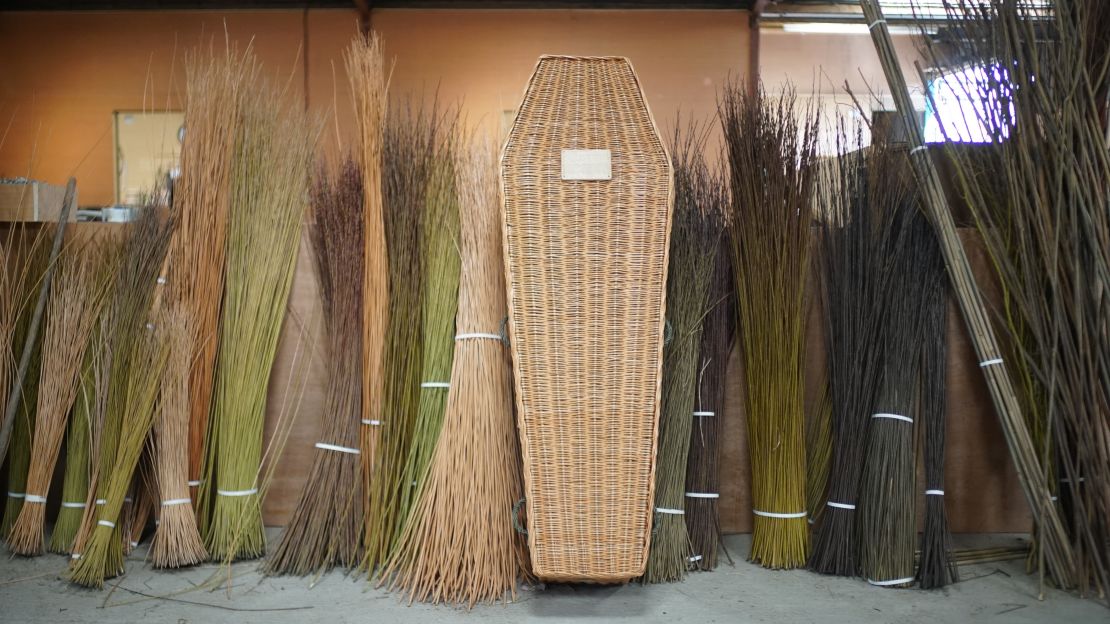Young ash trees are still in the morning sun, their leaves yet to grow full. At their feet, a hole, freshly dug, lies empty and waiting. Beside it, bundles of flowers, all tied with straw.
The only sound as the pallbearers walk through the woodland glade is the creaking of the coffin. It’s made of willow, a local wood, and fulfills the requirement that everything buried here is made of natural materials and is able to break down organically.
“We just wanted to be able to provide an opportunity for people to choose to be buried in a way that was helpful to the planet as opposed to damaging,” says the Reverend Canon Charles Royden.
He’s one of the founders of the St Albans Woodland Burial Trust, the organization that founded this burial ground in Bedfordshire, some 60 miles north of London.
Woodland burials are a type of a “natural” or “green burial,” where a body is laid to rest in as natural a way as possible, without harming the environment. Coffins and the clothes of the deceased must be made from natural materials and bodies shouldn’t be embalmed. If ashes are being buried, they must be in a biodegradable urn.

The practice has exploded in popularity across the UK. The first woodland burial ground is thought to have been in the municipal cemetery of the city of Carlisle, in the northwest of England, in 1993, where families were offered the opportunity to forsake traditional tombstones in favor of planting an oak tree.
“Britain has led the globe and the movement towards natural burials and they’ve become quite normalized now,” says Rosie Inman-Cook, the manager of the Natural Death Centre, a charity that gives advice on death and bereavement.
Inman-Cook says there are more than 300 natural burial sites in the UK, but as yet statistics aren’t collected on how many people have chosen this kind of burial.
The cost of death
There is a growing awareness of the environmental cost of burying our dead.
In the US alone, 4.3 million gallons of embalming fluid (which contains toxic ingredients such as formaldehyde, which can find their way into the soil), 1.6 million tons of concrete and 64,500 tons of steel are used in burials every year, according to the non-profit Green Burial Council. Cremations release a further 1.74 billion pounds of carbon dioxide – equivalent to 170,000 passenger cars driven for a year.
Some religions bury their dead in a way that is not harmful to the planet as a matter of course. In Judaism for example, coffins are traditionally made of natural wood such as pine and embalming is not allowed. In Islam too there is no embalming and a body is buried in just a linen or cotton shroud.
But in the UK, deliberately burying people to benefit the planet is a fairly new concept. Royden says that when he set up The Woodland Burial Trust in 2006, it was seen as “very wacky.” At the time, he estimated they would have a burial a month. Now they have several a week, with numbers increasing by nearly 30% last year.
“Many people are now choosing woodland burial just because they want to be friendly to the planet,” he says.
Natural burials can also be much cheaper than conventional ones. As well avoiding the cost of embalming, willow coffins cost around $700, compared to standard coffins that can cost thousands of dollars. The cost of a plot in a UK cemetery varies greatly depending on the location, but Woodland Burial Trust charges £850 ($1,180) for a space at its site.

Natural burials have been growing in popularity elsewhere. In the United States, a 2019 survey found that more than half of respondents were interested in exploring the options for a green burial. There are more than 300 green burial cemeteries in the United States and Canada, according to the Green Burial Council.
Sacred land
In the UK, natural burial sites are bound by law to protect the bodies interred there. The Woodland Burial Trust, however, has an extra layer of protection for its burial ground and its occupants for the future.
The land has been consecrated by the Church of England, and an ancient law gives consecrated ground protection forever unless an act of parliament decrees otherwise. “It sets the land aside for eternity, for the purpose of which is prescribed, in this case, woodland burial,” explains Royden.
The church is responsible for the upkeep of the site, and as it fills up, it aims to buy more farmland to expand the woodland. Built on old farmland, proceeds from the burials are being used to restore the 350 acres of native woodland that once grew here.
What was once farmland is now filled with trees, with simple wooden memorials marking where buried bodies are returning to nature.
“It is actually a beautiful way to have your last resting place,” says Royden.



